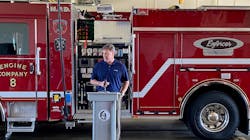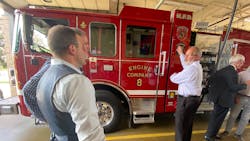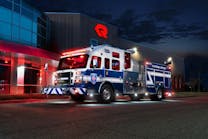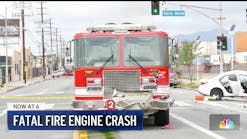First Pierce Electric Fire Truck Already Responding in WI City
Source Firehouse.com News
“This is what every fire chief dreams about, right?” Madison, WI, Fire Chief Steven Davis said. “Being on the cutting edge of change like this.”
Davis, talking outside Fire Station 8 on Madison’s east side, was reflecting on the event where they unveiled the first zero-emissions fire truck—built by Pierce Manufacturing—to hit the streets in North America.
The pumper, assigned to Engine 8, is built on a Pierce Enforcer cab and chassis and built with Pierce’s new Volterra technology in collaboration with parent company Oshkosh.
For more than 25 years, Oshkosh has manufactured electric drives for military and various industries and has refined them for emergency vehicles, Pierce President Jim Johnson said.
“This vehicle is designed around the firefighter," Johnson said. “They don’t have to comp on the leading edge of operational performance that they are used to, the functional, the safety attributes which are so important, the customization, and, let’s face it, the traditional style that they are used to.”
Gov. Tony Evers was proud of the collaboration between Wisconsin-based Pierce and the Madison Fire Department, saying, “We don’t have to choose between addressing climate change and protecting our environment and having good paying jobs and having good economic development.”
Development of Volterra in Madison’s fleet
Chief Davis first approached Pierce in 2018 with the concept of getting an electric fire truck as the city pushed the need for green vehicles with their goal of reaching sustainability by 2030.
“I think fire chiefs like myself all across the country are charged with this dilemma of how do we create this green fleet and become sustainable?” Davis said.
In 2019, Pierce and Madison Fire started collaborating on the design of the rig.
“Pierce looked at all of our run data and really designed the battery and drive system on how we use the vehicle day in and day out,” Davis explained of the process.
Pierce, the fire department, and Madison Gas and Electric collaborated to retrofit the station with an all-encompassing vehicle charging infrastructure to power the vehicle.
Since the 2018 directive for Madison’s fleet to be green by 2030, the city has placed 60 zero-emissions vehicles on the streets, adding that Engine 8 was number 61. The city also uses solar power grids and biodiesel to provide power for the vehicles in the city’s fleet.
Mahanth Joishy, the superintendent of Madison's Fleet Services, said vehicles are the single largest source of greenhouse gas emissions.
Rig specs
With the exception of a foot-wide starting at the running board to the top of the cab, between the cab and pump housing, the rig looks like any other pumper running on the streets of the Wisconsin capital.
The rig was customized for Engine 8’s response district, where the average response is four miles roundtrip for emergencies.
Developed by Oshkosh, the parallel-electric drivetrain features an electro-mechanical infinitely variable transmission that allows for zero-emissions using the integrated onboard batteries. The rig also features an internal combustion engine that provides uninterrupted power for extended operations.
The electric power comes from a 155 kW hour lithium-ion battery pack capable of powering the rig for 37 miles. Should there be a major fire where the rig will be pumping for an extended period of time, the truck will monitor the battery level and automatically transfer over to the internal combustion engine.
Pierce's Business Unit Director, Electrical & Software Technology, Eric Linsmeier, said the DC fast charger in the fire station can take the batteries from a completely discharged state to a fully charged state in under 90 minutes.
The smaller engine allows for a more spacious cab, Linsmeier said, adding that the lower profile engine tunnel improves visibility and provides the driver and officer with more room inside the six-person cab.
The rig has a 1,500-gpm single-stage pump with a 500-gallon tank and carries 1,000 feet of 5-inch hose and 850 feet of 2 ½-inch hose. There’s 150 cubic feet of storage, plus ladder storage.
The GVWR is 42,000 pounds and the vehicle features a TAK-4 Independent Front Suspension.
Volterra hit the streets in May
The pumper has been in service since May 21 and responded on close to 200 runs, Davis said, noting that there had been no reported challenges with the battery powered operation.
Davis said the first day the rig was in service they had 11 runs and the battery capacity never dropped below 74 percent with charging between runs.
Firefighters assigned to Engine 8 needed about three hours of additional training from Pierce on the electrical system, beyond the traditional in-service training they receive with the delivery of new apparatus. The training covered how to disconnect the system should there be an emergency, or how to manually switch over to the internal combustion system if the need arose.
Johnson said the rig had been tested in and around the Pierce plant in Appleton, WI, and even during 200 responses in Madison, nobody noticed that it was an electric rig instead of a diesel-powered apparatus.
“They are relieved that the vehicle works,” Davis said about the firefighters at Station 8.
Zero-emissions ARFF truck by Oshkosh
Oshkosh also announced another fire vehicle in the Volterra family.
The new Striker Volterra is a hybrid Aircraft Rescue and Fire Fighting (ARFF) vehicle available on 4x4 and 6x6 chassis.
The vehicle features a hybrid-electric drivetrain with an electro-mechanical infinitely variable transmission that provides zero-emissions operation when powered by the onboard batteries.
The rig boasts a faster acceleration, capable of achieving 28 percent improved acceleration when fully loaded.
What’s next?
As a prototype vehicle, Madison is expected to keep the vehicle in service for at least a year while Pierce collects data on Engine 8’s runs, vehicle performance, battery and charging life, and other operational points to help prepare Pierce for the future of zero-emissions fire apparatus.
Johnson said this partnership is going to change the way fire and emergency vehicles are powered in the near future.
“I’ve scratched my head and sit at my desk and think ‘how can this be’ because we still have to take care of our people. They still need to be able to fight fires and work normally and this really answers that,’ Davis said.

Peter Matthews | Editor-in-Chief/Conference Director
Peter Matthews is the conference director and editor-in-chief of Firehouse. He has worked at Firehouse since 1999, serving in various roles on both Firehouse Magazine and Firehouse.com staffs. He completed an internship with the Rochester, NY, Fire Department and served with fire departments in Rush, NY, and Laurel, MD, and was a lieutenant with the Glenwood Fire Company in Glenwood, NY. Matthews served as photographer for the St. Paul, MN, Fire Department.









